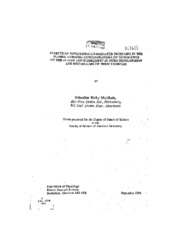| dc.description.abstract | A review of the literature indicated that high levels of protein in ruminant diets can lower fertility. Ammonia from proteins that are rapidly degraded by the rumen microbes has been suggested as the factor that may affect fertility. The mechanism(s) by which the detrimental effects of ammonia are manifested are speculative. However it seems that the concentration of ammonia in the reproductive tract may be responsible for embryo mortality in sheep as was found in the present study. This study was planned to investigate some of the possible mechanism(s) by which ammonia affects embryo survival in ewes. Due to the fact that "urea-molasses" blocks are used as a strategy for better utilization of low quality roughages in both hill environments in Britain and in tropical conditions, urea was used as a source of highly degradable nitrogen in the present study. Twelve ewes were used, balanced for weight and randomly allocated to two treatments. The two treatments were designed to supply the maintenance energy needs of the ewes. The control diet contained 2 g urea/day to meet but not exceed the needs of the rumen microbes for degraded protein, and the "urea-diet” contained 48g urea/day. Therefore rumen degradable protein was in excess of rumen microbial needs to the extent of about 136 g/day in the ”urea-diet". Ewes were given a single injection of PGF2 a on the day preceding the introduction of the experimental diets. An exogenous source of progesterone was given via a controlled internal drug release (CIDR) device containing 0.3 g progesterone and this was left in place for 12 days.. Superovulation was induced by a series of injections of porcine follicle stimulating hormone (FSH). Daily collection of blood samples started just before insertion of the CIDR device and the plasma was later analysed for progesterone. Starting at 10 hours after the removal of the CIDR device plasma samples were collected at 2-hour interval for the next 30 hours and analysed for LH, glucose, insulin, urea and ammonia. Laparoscopy was used to deposit semen directly into the uterine horns 52 hours after the removal of the CIDR device. At Day 3 post insemination, embryos were recovered by mid-ventral laparotomy. Visual assessment of embryos was carried out at the time of recovery using a stereomicroscope (x50 magnification) and thereafter using an inverted microscope (x200 magnification). The embryos were then incubated for 3 hours in synthetic oviductal fluid medium (SOFM) labelled with [5-3H] glucose and [U-glucose immediately following recovery, and after 72 hours in in—vitro co-culture. After 96 hours in co-culture the embryos were incubated in ovine culture medium (OCM) labelled with 35S- Methionine for 2 hours. Progesterone concentrations were 1.91±0.15 in the urea-fed as opposed to 1.55±0.12 ng/ml in the control ewes. However the times of the LH peak and oestrus were not different for the control and the urea-fed animals (20.4±2.48 versus 22.9±1.68 and 18.4±2.93 versus 18.3±1.82 and hrs respectively), neither were ovulation rates (6.5±1.41 and 7.0±1.09) or the numbers of embryos recovered (4.3±1.20 and 4.4±1.19). Plasma insulin and glucose concentrations were significantly higher (p<0.001) in urea- as opposed to control-fed ewes,48.5±1.97 versus 34.9±1.27 gU/ml, and 3.95±0.053 versus 3.64±0.045 mmol/1, for the urea- and control-fed ewes respectively. Significantly higher concentrations of urea (p<0.001), 5.47±0.152 for the urea as opposed to 2.41±0.099 mmol/1 for the control' ewes, and ammonia (p<0.01) 90.4±9.22 and50.9±6.92 pmo/l were measured in plasma.There were higher levels of ammonia and urea in the flushings from the reproductive tracts of the urea-fed than control ewes (63.6±7.50 gmol/1 and 0.414±0.084 mmol/1 versus 35.7±4.30 /imol/1 and 0.185±0.044 mmol/1 respectively)The percentage of well-developed embryos from the urea-fed ewes was greater than for the controls(90% versus 79%) at the time of recovery. There was also a greater number of viable embryos from the urea-supplemented ewes than from the controls. After 72 hours in co-culture the percentages of viable embryos for the control ewes were 59% compared with 46% for the "urea-fed" ewes. Glucose metabolism by the embryos as measured by the production of HO and uC02 was positively correlated to stage of development. On the day of embryo collection viable embryos from "urea-fed” ewes were metabolically more active than those from the control animals. There was a close association between the amounts of radio-active H20 and C02 generated by viable embryos from both treatment groups (r=0.470, p=0.012). On the third day of in vitro culture there was however no significant difference in the glucose metabolism between viable embryos from urea and control animals (p=0.61); 13.21+2.50 versus 11.53±1.91 pmol/embryo of 3H2O, and 0.344±0.059 versus 0.262±0.043 pmol/embryo of uC02.Protein synthesis by viable embryos was not different between the treatment groups. There was a positive correlation between the rate of protein synthesis by the embryo and its glucose metabolism. The study indicates that there is scope for the application of measurements of embryonic metabolic activity in the assessment of embryo viability. It is concluded that ammonia from "urea-supplemented” diets affects embryo development. The initial response of the embryo appears to involve an enhanced rate of development which in the present study was associated with an enhanced metabolic activity and an associated increase in protein synthesis. In view of the eventual reduction in embryo survival it is assumed that this initial response is eventually detrimental although it may also explain the enhanced birth weight of lambs produced from the small number of embryos that survive. There was no evidence in the present study that the high-urea diet gave rise to embryos with an altered proportion of their energy metabolism occurring via the pentose-phosphate shunt as opposed to the glycolytic pathway. | en_US |

